Naqsh-e Jahan Square, also known as Imam Square, is one of the most beautiful destinations in Isfahan tours. In fact, many of the city’s ancient structures are concentrated around this square. Throughout its history under various governments, this beautiful square has seen many ups and downs, sometimes neglected by rulers, but today, it enjoys immense popularity worldwide.
Its inclusion in the UNESCO World Heritage List underscores the significance of this area. When visiting Isfahan, you can spend a great deal of time in this beautiful square, enjoying the view of historical buildings and its stunning nature.
In this article, we will explore the historical attractions of Naqsh-e Jahan Square. Join us as we tell you about the unique features of this historic square.
About Naqsh-e Jahan Square
Naqsh-e Jahan Square in Isfahan is a prominent historical complex in Iran and the world. This beautiful square annually hosts numerous tourists eager to see its historical attractions and beauty. Known as Shah Square before the revolution, it was later renamed to Imam Square. Other historical names for Naqsh-e Jahan Square include Great Square, Main Square, New Square, Palace Square, and Royal Square.
Before the Safavid era, a beautiful garden named “Naqsh-e Jahan” existed at the site of the square. The garden was named after a city in Azerbaijan, now called Nakhchivan. Hamdallah Mustawfi describes the old city in his travelogue: Imam Square, located in the north of Isfahan and in the heart of the city’s historical complex, once served as the Safavid kings’ government house. Its most glorious era dates back to the time of Shah Abbas the Great. With the transfer of the capital from Qazvin to Isfahan, Shah Abbas built the square’s historical buildings, boosting the local economy and expanding the market. The newly built square was then called “New Square.”
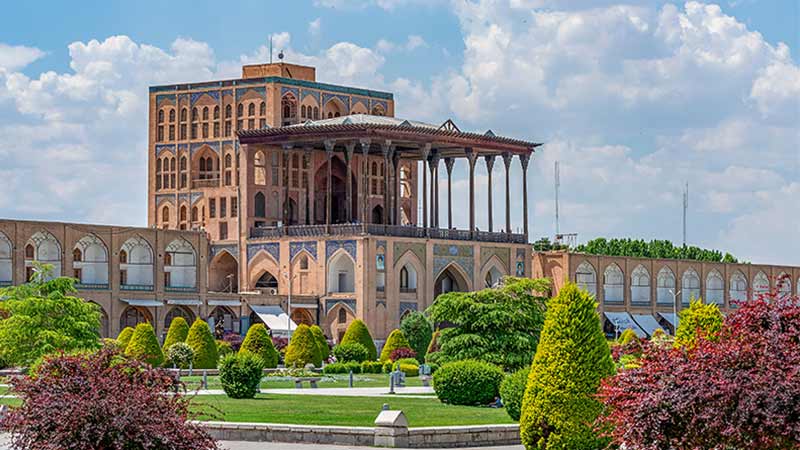
The square was later expanded during the reign of Shah Abbas II and was renamed Naqsh-e Jahan. Its design was inspired by the older Atiq Square in Isfahan.
Naqsh-e Jahan Square is over 500 meters long and 160 meters wide. It is surrounded by 200 two-story shops. Four significant historical buildings are situated in different parts of the square. Throughout history, arcades have been built around the square to protect the buildings, which have evolved into today’s shops.
Naqsh-e Jahan Square in Isfahan has many admirers worldwide and was registered as a national monument of Iran on February 8, 1934. In May 1979, it became one of the first Iranian sites to be listed by UNESCO.
History of Naqsh-e Jahan Square
Before the rise of the Safavid dynasty, a large garden existed where Naqsh-e Jahan Square now stands. In the central part of the square, known as “Dar Kushk,” there were military buildings from the Timurid and Aq Qoyunlu periods. This part of the square, now home to the Ali Qapu Palace, was the western section of today’s square. Since the Seljuk era, the square has hosted national celebrations like Nowruz and served as an execution site. With the Safavids moving the capital from Qazvin to Isfahan, the square’s era of grandeur began, becoming the site for government buildings and the Shah’s palace.
Shah Abbas the Great, aiming to expand the city towards the south near the Zayandeh River, laid the foundation of the square with the help of skilled architects like Master Mohammad Reza and Ali Akbar Isfahani. The square and its historical buildings were designed using the Iranian square architectural style, with notable examples being Atiq Square in Isfahan, Amir Chakhmaq Square in Yazd, Shah Square and Saheb Abad Square in Qazvin.
Artistic elements in the square’s buildings include a calligraphy plaque by Alireza Abbasi on the entrance of the Imam Mosque. This plaque, written in Thuluth script, praises Shah Abbas I. Another plaque on the entrance of the Jameh Mosque is adorned with the calligraphy of Mohammad Reza Emami, showcasing the names of the structure’s prominent architects.
The initial foundation of today’s Imam Square was laid in the year 1011 AH, and its construction and buildings were completed by 1025 AH. The mosque and buildings’ decoration began in 1025 AH and continued during the reign of two of Shah Abbas’s successors.
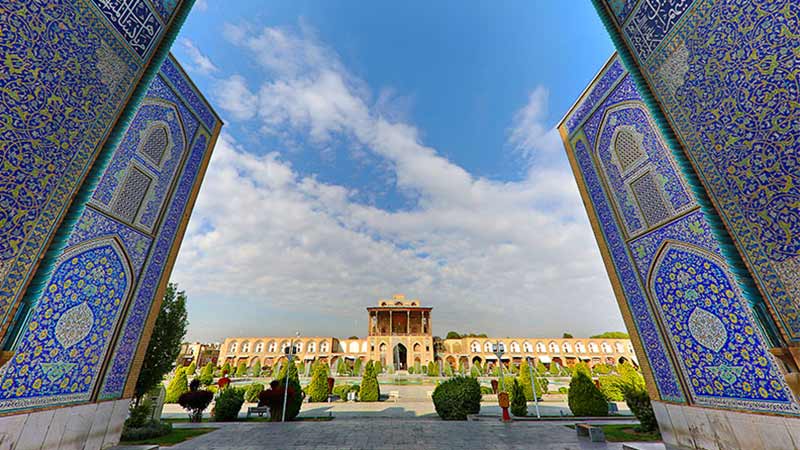
Many parts of the Naqqareh Khaneh mansion were destroyed due to the negligence of Qajar kings. During the last Safavid rulers, Shah Suleiman and Shah Sultan Hussein, the square lost its glory, with the water in the canals becoming turbid and stagnant and the trees drying up. This destruction accelerated during Ashraf Afghan’s attack on Isfahan and continued during the Qajar era.
Under the first Pahlavi government, Reza Khan began the restoration of historical buildings and shops around Naqsh-e Jahan, reviving the square’s economic prosperity. It was registered as a historical site of Iran during Reza Khan’s rule. Since then, the preservation of this valuable historical heritage has continued. In recent years, the construction of the Jahan Nama Tower in Isfahan near Naqsh-e Jahan Square caused much controversy, ultimately leading to the demolition of two floors of the tower to protect the square’s cultural landscape.
Naqsh-e Jahan Square remains one of the world’s largest squares today. As described by foreign travel writers, its beauty is indescribable. The square was historically the site for royal celebrations, polo games, military parades, Friday markets, and numerous shows, all illuminated with lights. For ordinary people, the inner space of Naqsh-e Jahan Square was the best place for strolling and shopping. Two stone polo gates in the square are the oldest polo gates in the world. The design of foreign polo grounds was inspired by Naqsh-e Jahan Square. Imam Square is the world’s oldest polo ground.
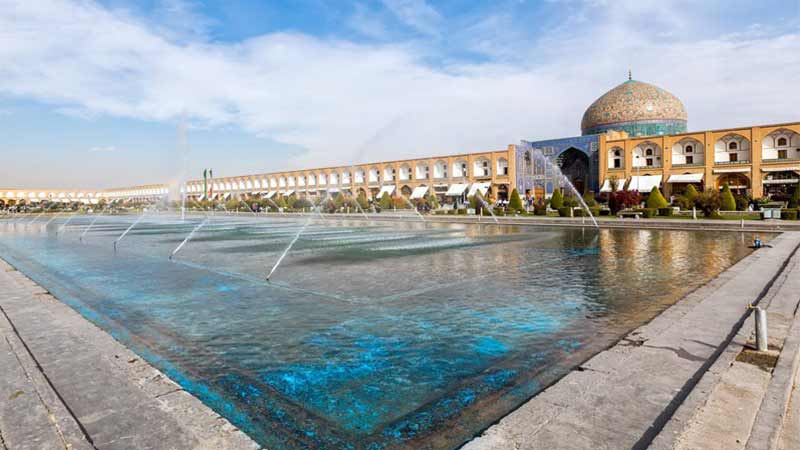
Attractions of Naqsh-e Jahan Square
Each of the historical buildings in this square symbolized urban life, social unity, and national solidarity. Abbasi Jameh Mosque or Shah Mosque on the southern side of the square was the city’s social center, built for large public gatherings. Sheikh Lotfollah Mosque on the eastern side served as a religious center, Ali Qapu Palace in the west was the government center, and the northern Qeysarie Gate was an important economic hub.
The square is surrounded by historical shops, now the main center for selling Isfahan’s handicrafts. The restoration of these old Naqsh-e Jahan shops, aimed at preserving art and expanding local handicrafts, has taken place in recent years. Two old polo gates also remain as historical relics of the square. In this section, we introduce these prominent historical buildings.
Abbasi Jameh Mosque (Imam Mosque)
Imam Mosque in Isfahan is the most important historical mosque remaining from the Safavid era. Construction of this structure began in 1020 and its decorations were completed during Shah Suleiman’s reign. The mosque’s architect was the renowned artist Ali Akbar Isfahani, and its entrance calligraphy was the work of the famous Safavid calligrapher, Alireza Abbasi. Artworks and inscriptions by other prominent artists can also be found in different parts of the mosque.
Imam Mosque is a hallmark of Safavid architecture, with its minarets and dome featuring highly artistic tilework. The sound reflection under the dome is a unique feature of the Abbasi Jameh Mosque. The mosque was also known as Shah Mosque, Kabeer Abbasi Mosque, and Sultani Mosque in the past.
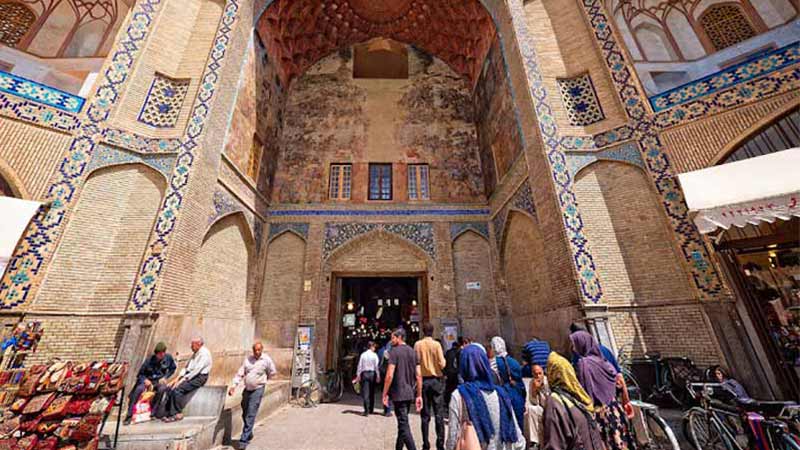
Ali Qapu Palace
Ali Qapu Palace is located on the western side of Naqsh-e Jahan Square and spans approximately 1,800 square meters across six floors. Notable features of this palace include the beautiful decorations on each floor, the sound reflections at the entrance, an exquisite reception hall, and the main music hall. The palace houses 53 rooms used for rest, meetings, government affairs, and hosting diplomats and guests. The architecture of this government house is based on wooden pillars. This beautiful structure continues to be restored and renovated.
Sheikh Lotfollah Mosque
Among the world’s most beautiful historical mosques is the Sheikh Lotfollah Mosque in Isfahan. Built by order of Shah Abbas I for his exclusive use, this mosque is situated on the eastern side of Naqsh-e Jahan Square. During the Qajar Dynasty, the main building and its decorations suffered significant damage, but were later restored by Reza Shah Pahlavi. The construction of its 32-meter dome took 17 years, and the mosque’s dome tiles are the result of restorations completed in 1315. Unlike other Safavid-era mosques, it lacks a courtyard and minaret. The entrance features a calligraphy inscription by the renowned Ali Reza Abbasi.
Qeysarie Gate
Qeysarie Gate, located on the northern side of Naqsh-e Jahan Square, is the entrance to Isfahan’s famous traditional bazaar. The third floor of this bazaar was formerly a music room, announcing different times of day with music. This part was destroyed during the Qajar era. The gate includes four subsidiary doors and a main entrance. In 1340, the pool in front of this gate was converted into a garden, but has since been restored. The gate is named for its resemblance to a structure in the city of Kayseri. Notable remnants in this historical structure include paintings by Reza Abbasi, the bell from the Hormuz Monastery, and the clock from the Portuguese Castle of Hormuz, both relics of the Safavid conquest of the Hormuz Island.

What to Do in Naqsh-e Jahan Square?
A visit to Isfahan is incomplete without spending a memorable day at Naqsh-e Jahan Square, a historical site comparable in attractions to a city. To fully enjoy the area and its amenities, consider spending several days there. The square’s appearance transforms beautifully throughout the day and night, especially with the lighting of its historical buildings, making it a must-see destination in Isfahan at night. This section introduces some of the sights and activities to do in Isfahan, Naqsh-e Jahan Square.
Explore Historical Attractions
Naqsh-e Jahan Square is one of Isfahan’s major tourist attractions. Devote a day or more to exploring its historical buildings, adorned with significant art and historical objects. Each building has guides available to provide information and answer questions. Spending extended time in these historical structures offers a deep dive into history, creating unforgettable memories.
Shop in the Market and Buy Souvenirs
Qeysarie Bazaar at Naqsh-e Jahan Square is one of Isfahan’s best shopping centers, offering local handicrafts, carpets, copperware, and dried fruits. The nearby Grand Bazaar of Isfahan, also covered, offers reasonably priced goods. Shops around the square have a wide variety of products and crafts, but tend to be pricier than those in the Qeysarie and Grand Bazaars.
Enjoy Walking and Carriage Rides
The square’s beautiful flower arrangements and turquoise pools with tall fountains create a joyful atmosphere. Spend time admiring this colorful space, and enjoy walking around it. Numerous benches are available for resting and admiring the surroundings. Carriage rides around the square are also available, offering a charming way to see the sights.
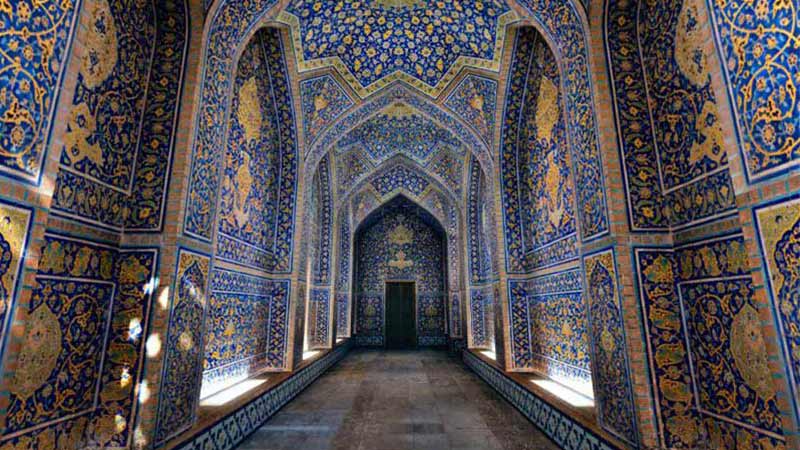
Visit Cafés and Restaurants
Around Naqsh-e Jahan Square, you’ll find a variety of delicious local foods, from ice cream, desserts, and sweets like Pashmak, to Ash Reshteh, Fereni, Baklava, Doogh, and the popular Goshfil of Isfahan. Dizi Sara-e Chah Haj Mirza offers traditional meals in a pleasant setting, while Qeysarie Gallery Café and the traditional Hoogar Café are among the best options for café hopping. The interior of Namakdan Café-Restaurant and Roozegar Sherbet House is also noteworthy, adorned with antiques and vintage items. After exploring the square, enjoying a fragrant, traditional drink in these cafés is unforgettable.
Don’t Forget to Take Photos
Capture beautiful images of this picturesque square to preserve your travel memories. The historical buildings, natural beauty, traditional cafes, sunset views, and night-time lighting make excellent subjects for memorable photographs.
Conclusion
In conclusion, Naqsh-e Jahan Square is a breathtaking and historically rich site in Iran, offering a glimpse into the beauty of Persian culture and architecture. If you enjoyed this article about Naqsh-e Jahan Square or have any thoughts to share, please leave a comment. We always appreciate hearing your experiences and insights!



